
Rocks and Their Formation
Course
Overview
Earth and space sciences are investigated in more detail in
this course. Earth's characteristics, resources and location in the solar
system are identified and their implications explored. Students also learn
about the interrelationship of organisms and ecosystems and simple food chains
and food webs. Energy and energy transfer through an electrical current are
addressed. Students will describe and illustrate the design process and
describe the positive and negative impacts of human activity and technology on
the environment. Students observe, measure and collect data when conducting a
scientific investigation; students use this information to formulate inferences
and conclusions; and students develop skills to communicate the results.
Labs - In this course, there may be some lab activities that require normal household items for completion. If you do not have the items required for a particular lab activity, please contact your online teacher for accomodation.
Unit Overview
In this
Unit we will talk about the crust of the earth, rocks, volcanoes and
earthquakes and how each influences the characteristics of the earth’s surface.
You will read a short story about a young boy named Paul. Read to find out what
Paul discovered in his own backyard.
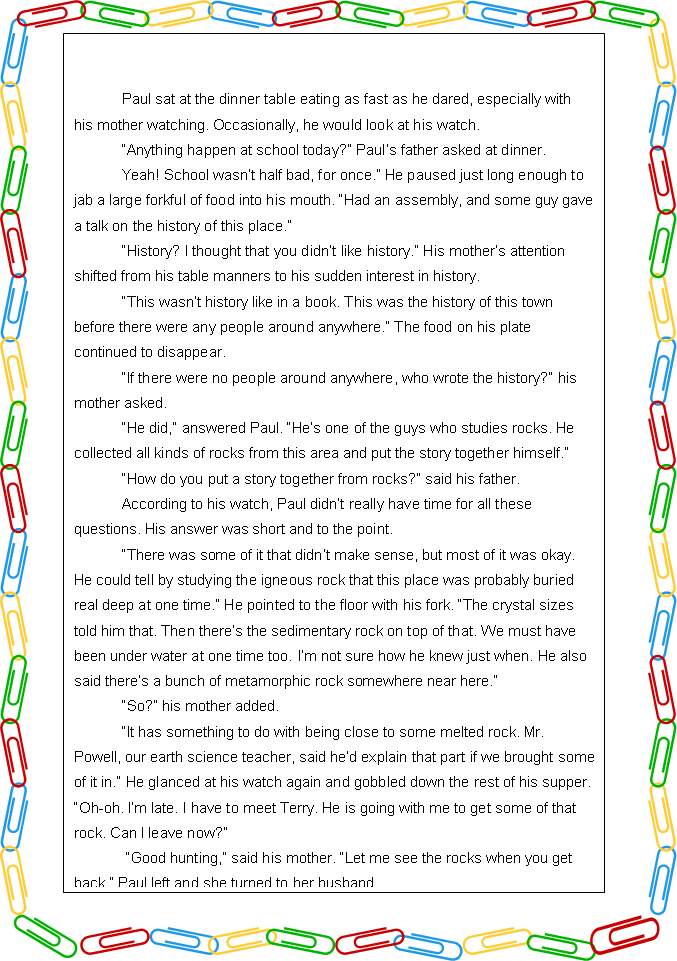
You can see how Paul’s mother pictured the history of the
area. If Paul had not left out so much, his mother might not have been so
confused.
What Is Rock?
Paul never did get around to saying what a rock is. Everyone
knows that there is a hard material called “rock” which is found in some road
cuts, hillsides, and riverbanks. You know that it is covered up in most places
by dirt and plants. You know that it is a natural material. Rock is the
solid part of the earth’s crust, is made of minerals, not part of any
living organism, and not made by man. Smaller pieces which have broken off from
the main mass of rock are usually called “rocks.”
There are three kinds of rocks and, Geologists, who
are scientists who study what makes up the earth and how the earth changes,
understand and explain these differences.

Molecules in rocks may line up in regular patterns called Crystals.
Crystals sometimes form when some liquids turn to solids. For example, ice
crystals and snowflakes form when liquid water freezes. So mineral crystals may
tell us that some forces were once melted and part of a “mineral soup.” The
real buried mineral soup is called magma. To turn into rock, magma has
to cool. Rocks formed from magma are called igneous (IG-nee-us) rocks,
meaning “from fire.”
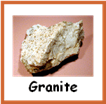
Here is an experiment to do. It involves growing crystals
around different objects. Have an adult help you with the heating of the water.
Watching Crystals Grow
Objectives 
· Observe
and record factors that influence crystal growth.
·
Identify the structure of crystals.
Select and safely use the following materials:
![]() Ten or more shallow bowls (such as
petri dishes)
Ten or more shallow bowls (such as
petri dishes)
 Five small, clean rocks
Five small, clean rocks
![]() Four small miscellaneous objects
(such as nails, aluminum foil, shells, or marbles.)
Four small miscellaneous objects
(such as nails, aluminum foil, shells, or marbles.)
Pan for heating, heat source
Spoon and measuring cup ![]()
Four cups of Epsom salts (not table
salt, but crystals of hydrated magnesium sulfate available at most pharmacies)
Two cups of water ![]()
Magnifying glass ![]()
Flashlight ![]()
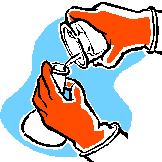 Observation sheets
Observation sheets 
Proceed with care.
1. Separate the bowls into five
pairs. Place small rocks in one of each pair. Choose several small,
miscellaneous objects to put into four of the other bowls. Leave one bowl
empty. Number each bowl.
2. Heat two cups of water in the pan, slowly adding the four cups of Epsom
salts. Continually stir the mixture so that the salts dissolve, but don't allow
it to boil!
3. Divide the mixture among the ten bowls. Don't worry about dividing it
exactly, but make sure that the mixture completely covers the objects in the
bowls.
4. Put two drops of food coloring in the center of several of the bowls.
5. Put five of the bowls in a cool part of the room and five in a warm part of
the room, where they will not be touched or disturbed.
Use Evidence and Observation to Explain and Communicate the
Results of the Investigation. You will record the results by answering the questions in
the questions segment.
·
Questions 1-7 below refer to Bowl 1
·
Questions 8-14 refer to Bowl 2
·
Questions 15-21 refer to Bowl 3
·
Questions 22-28 refer to Bowl 4
·
Questions 29-35 refer to Bowl 5
·
Questions 36-42 refer to Bowl 6
·
Questions 43-49 refer to Bowl 7
·
Questions 50-56 refer to Bowl 8
·
Questions 57-63 refer to Bowl 9
· Questions 64-70 refer to Bowl 10
You should observe the bowls at the start (immediately after the water is
poured into the bowl) and write down what you see. At this point the liquid
should be clear and not have any solid particles in it.
Now observe the bowls again after a few hours if possible and write down any
changes you see. At this stage the crystals should begin forming, but there
will also be a lot of liquid left.
Continue the observation for several days until crystal
formation has stopped. As the crystals form, remove a few for observation under
a magnifying glass or microscope.
On paper draw a series of pictures of the crystals as they
grow, focusing on the shape and growth patterns. Think about the following
points. These will help as you record your observations in questions 1-70.
· Do the crystals have any similarities
in terms of shape and symmetry when observed under the microscope or with a
magnifying glass?
· How many sides (faces) does each of
the crystals have?
· Does shining a flashlight on the
surface of the crystals affect their appearance?
· When did the crystals stop growing?
Did some stop growing before others?
· Did temperature affect the rate of
crystal growth or the size of the crystals? Were warm or cold temperatures more
favorable?
· Did crystals grow in all the bowls?
If not, what may be some of the reasons why the crystals did not grow?
· Did crystals appear to grow more
easily on rocks or metal? On smooth or rough objects?
· Compare and contrast: Look through a
magnifying glass at commonly occurring crystals such as table salt and refined
sugar.
· How are these crystals similar to and
different from those grown in dishes?
You should notice that crystals do not grow easily on smooth
surfaces like marbles or metal. You also should observe that the dishes that
cooled slower should have larger crystals but took longer to form. Everything
does not always go right when you do an experiment, so look for factors that
may have made a difference in the results.
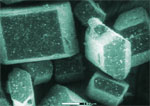
Table sugar crystals, magnified 100
times
If you have any questions contact your Virtual Learning
teacher.
Now, some major points
to remember.
· Magma is a mixture of melted
minerals.
· Rocks that form from magma are called
igneous rocks.
· The heat to melt minerals comes from
the original heat inside the earth and from radioactive decay.
· Fast cooling will probably produce no
crystals at all, medium-fast cooling usually produces medium sized crystals,
and slow cooling produces large crystals.
Rock at the surface of the earth naturally breaks up. The
weather, running water, chemicals, and man all contribute to the process of
rock deposits breaking into “rocks”. It is chipped, splashed on, eaten by
acids, and carried away a piece at a time by streams. The pieces, called sediment
(SED-ih-ment), eventually collect in deposits or piles. Follow a stream some
time and see if you can find one of the sediment deposits. Look at a handful of
sand. Where did it come from? Could it have come from a piece of granite? Could
other types of rock besides granite be a part of that sand? Yes, of course
other types of rock can be broken down. When this sediment is deposited, at the
end of a river or at the bottom of a large body of water, all those pieces
become cemented together after eons of time to form another rock. Rocks that
have been made by cementing sediment together are called sedimentary
(sed-ih-MEN-tree) rocks.
You can make your own sedimentary rock by mixing 1/2 cup of
glue and 1/2 cup of water together. Let it stand for a few minutes. Take a
paper cup and punch about ten small holes in it. Then, put a handful of pebbles
or crushed stone from a driveway into the paper cup with the holes. Pour the
glue mixture through the cup. Have another cup underneath to catch what runs
out the holes. Wait a few minutes. Then pour what you caught back over the
pebbles and again catch what runs out. Keep doing this a few more times,
remembering to wait a few minutes between each pouring. After you are done put
the cup in a warm place to dry overnight. The next day tear the paper cup off.
What you are looking at is a sample of Sandstone.
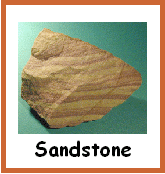
There are many other kinds of sedimentary rocks. Some
sedimentary rocks do not need cement like the glue to keep them together.
Sedimentary rocks contain records of the past.
Major points:
· Pieces of rocks can become cemented
together to form new rocks.
· The dissolved shells of sea animals
can act as cement.
· The rocks formed by the cementing of
small pieces of sediment is called sedimentary rock.
· Sedimentary rocks may contain records
of the past events and past life.
· Minerals or other compounds that have
been left behind as water evaporated or that have dropped out of a water
solution because of temperature changes also form sedimentary rocks.
What happens to rock pieces after they have been cemented
together? Rain, wind, chemicals, and ice still erode them. Streams still carry
off the chipped-away pieces if the rock gets to the Earth’s surface. But, what
happens to rock that doesn’t get to the surface? Suppose more and more sediment
keeps piling on top of it. Will it remain sedimentary rock forever? Maybe the
sedimentary rock will be buried so deeply that the heat of the earth begins to
raise the temperature of the rock. The sedimentary rock could get hot enough to
turn into magma. The new magma might even reach the surface to start the entire
process all over again.
Geologists have found that this does happen to some
sedimentary rock. But, they have also found that sometimes sedimentary rock
melts and cools again without turning into magma. Sometimes, tremendous
pressure squeezes the rock until the minerals actually flow, without melting.
 Rock that has been changed by heat or pressure or both is
called metamorphic (met-uh-MOR-fik) rock. This changing process
sometimes makes the metamorphic rock harder than the original rock.
Rock that has been changed by heat or pressure or both is
called metamorphic (met-uh-MOR-fik) rock. This changing process
sometimes makes the metamorphic rock harder than the original rock.
Not only can sedimentary rocks be changed, but also, igneous
rocks can be changed.
Major points:
· Rocks can be buried deeply enough to
melt again. A new igneous rock may then be formed.
· Rocks can be changed by heat and
pressure. These rocks are called metamorphic rocks.
· While igneous rocks are in the liquid
(magma) form because of heat and pressure, some of their crystals may change
structure and flow.
· When sedimentary rock changes form,
the new rock is sometimes harder and sometimes contains more kinds of crystals.
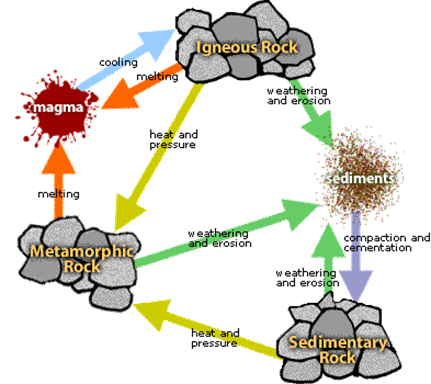
For additional information on rocks, click on this link https://www.rocksforkids.com/
Make sure that you looked at all the types of:
I. Sedimentary Rocks: Sandstone,
Limestone, Shale, Conglomerate and Gypsum.
II. Metamorphic Rocks: Schist and
Gneiss
III. Igneous Rocks: Granite, Scoria,
Pumice and Obsidian